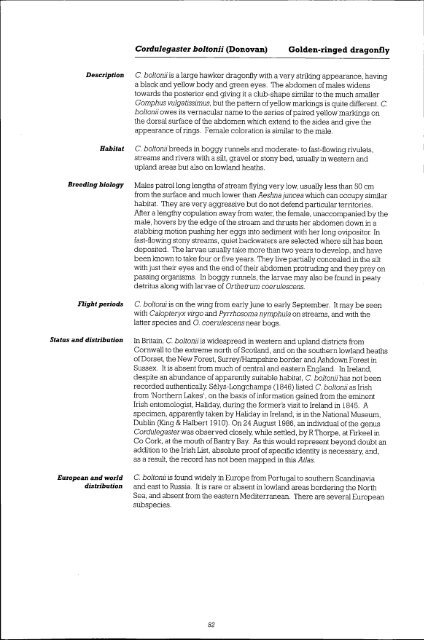Download - NERC Open Research Archive - Natural Environment ...
Download - NERC Open Research Archive - Natural Environment ...
Download - NERC Open Research Archive - Natural Environment ...
Create successful ePaper yourself
Turn your PDF publications into a flip-book with our unique Google optimized e-Paper software.
Status and distribution<br />
Cordulegaster boltonii (Donovan) Golden-ringed dragonfly<br />
Description C. boltonil is a large hawker dragonfly with a very striking appearance, having<br />
a black and yellow body and green eyes. The abdomen of males widens<br />
towards the posterior end giving it a club-shape similar to the much smaller<br />
Gomphus vulgatissimus, but the pattern of yellow markings is quite different. C.<br />
boltonii owes its vernacular name to the series of paired yellow.markings on<br />
the dorsal surface of the abdomen which extend to the sides and give the<br />
appearance of rings. Female coloration is similar to the male.<br />
Habitat C. boltonii breeds in boggy runnels and moderate- to fast-flowing rivulets,<br />
streams and rivers with a silt, gravel or stony bed, usually in western and<br />
upland areas but also on lowland heaths.<br />
Breeding biology Males patrol long lengths of stream flying very low, usually less than 50 cm<br />
from the surface and much lower than Aeshna juncea which can occupy similar<br />
habitat. They are very aggressive but do not defend particular territories.<br />
After a lengthy copulation away from water, the female, unaccompanied by the<br />
male, hovers by the edge of the stream and thrusts her abdomen down in a<br />
stabbing motion pushing her eggs into sediment with her long ovipositor. In<br />
fast-flowing stony streams, quiet backwaters are selected where silt has been<br />
deposited. The larvae usually take more than two years to develop, and have<br />
been known to take four or five years. They live partially concealed in the silt<br />
with just their eyes and the end of their abdomen protruding and they prey on<br />
passing organisms. In boggy runnels, the larvae may also be found in peaty<br />
detritus along with larvae of Orthetrum coerulescens.<br />
Flight periods C. boltonii is on the wing from early June to early September. It may be seen<br />
with Calopteryx virgo and Pyrrhosoma nymphula on streams, and with the<br />
latter species and 0. coerulescens near bogs.<br />
In Britain, C. boltonii is widespread in western and upland districts from<br />
Cornwall to the extreme north of Scotland, and on the southern lowland heaths<br />
of Dorset, the New Forest, Surrey/Hampshire border and Ashdown Forest in<br />
Sussex. It is absent from much of central and eastern England. In Ireland,<br />
despite an abundance of apparently suitable habitat, C. boltonii has not been<br />
recorded authentically. Sélys-Longchamps (1846) listed C. boltonii as Irish<br />
from 'Northern Lakes', on the basis of information gained from the eminent<br />
Irish entomologist, Haliday, during the former's visit to Ireland in 1845. A<br />
specimen, apparently taken by Haliday in Ireland, is in the National Museum,<br />
Dublin (King & Halbert 1910). On 24 August 1986, an individual of the genus<br />
Cordulegasterwas observed closely, while settled, by R Thorpe, at Firkeel in<br />
Co Cork, at the mouth of Bantry Bay. As this would represent beyond doubt an<br />
addition to the Irish List, absolute proof of specific identity is necessary, and,<br />
as a result, the record has not been mapped in this Atlas.<br />
European and world C. boltonli is found widely in Europe from Portugal to southern Scandinavia<br />
distribution and east to Russia. It is rare or absent in lowland areas bordering the North<br />
Sea, and absent from the eastern Mediterranean. There are several European<br />
subspecies.<br />
82

















